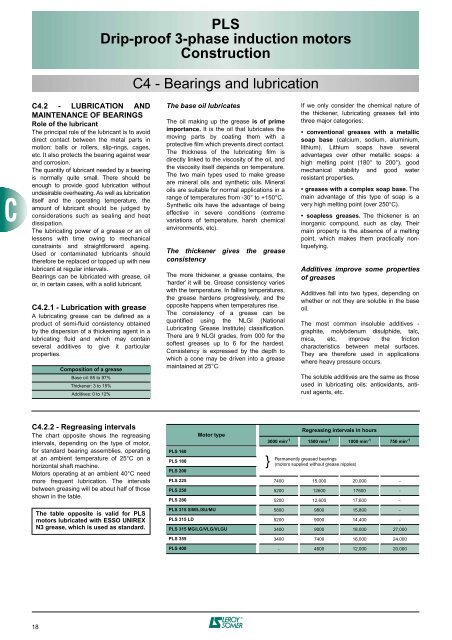PLS Drip-proof 3-phase induction motors - Etum Elektronik
PLS Drip-proof 3-phase induction motors - Etum Elektronik
PLS Drip-proof 3-phase induction motors - Etum Elektronik
Create successful ePaper yourself
Turn your PDF publications into a flip-book with our unique Google optimized e-Paper software.
C4.2 - LUBRICATION AND<br />
MAINTENANCE OF BEARINGS<br />
Role of the lubricant<br />
The principal role of the lubricant is to avoid<br />
direct contact between the metal parts in<br />
motion: balls or rollers, slip-rings, cages,<br />
etc. It also protects the bearing against wear<br />
and corrosion.<br />
The quantity of lubricant needed by a bearing<br />
is normally quite small. There should be<br />
enough to provide good lubrication without<br />
undesirable overheating. As well as lubrication<br />
itself and the operating temperature, the<br />
amount of lubricant should be judged by<br />
considerations such as sealing and heat<br />
dissipation.<br />
The lubricating power of a grease or an oil<br />
lessens with time owing to mechanical<br />
constraints and straightforward ageing.<br />
Used or contaminated lubricants should<br />
therefore be replaced or topped up with new<br />
lubricant at regular intervals.<br />
Bearings can be lubricated with grease, oil<br />
or, in certain cases, with a solid lubricant.<br />
C4.2.1 - Lubrication with grease<br />
A lubricating grease can be defined as a<br />
product of semi-fluid consistency obtained<br />
by the dispersion of a thickening agent in a<br />
lubricating fluid and which may contain<br />
several additives to give it particular<br />
properties.<br />
18<br />
Composition of a grease<br />
Base oil: 85 to 97%<br />
Thickener: 3 to 15%<br />
Additives: 0 to 12%<br />
C4.2.2 - Regreasing intervals<br />
The chart opposite shows the regreasing<br />
intervals, depending on the type of motor,<br />
for standard bearing assemblies, operating<br />
at an ambient temperature of 25°C on a<br />
horizontal shaft machine.<br />
Motors operating at an ambient 40°C need<br />
more frequent lubrication. The intervals<br />
between greasing will be about half of those<br />
shown in the table.<br />
The table opposite is valid for <strong>PLS</strong><br />
<strong>motors</strong> lubricated with ESSO UNIREX<br />
N3 grease, which is used as standard.<br />
<strong>PLS</strong><br />
<strong>Drip</strong>-<strong>proof</strong> 3-<strong>phase</strong> <strong>induction</strong> <strong>motors</strong><br />
Construction<br />
C4 - Bearings and lubrication<br />
The base oil lubricates<br />
The oil making up the grease is of prime<br />
importance. It is the oil that lubricates the<br />
moving parts by coating them with a<br />
protective film which prevents direct contact.<br />
The thickness of the lubricating film is<br />
directly linked to the viscosity of the oil, and<br />
the viscosity itself depends on temperature.<br />
The two main types used to make grease<br />
are mineral oils and synthetic oils. Mineral<br />
oils are suitable for normal applications in a<br />
range of temperatures from -30° to +150°C.<br />
Synthetic oils have the advantage of being<br />
effective in severe conditions (extreme<br />
variations of temperature, harsh chemical<br />
environments, etc).<br />
The thickener gives the grease<br />
consistency<br />
The more thickener a grease contains, the<br />
‘harder’ it will be. Grease consistency varies<br />
with the temperature. In falling temperatures,<br />
the grease hardens progressively, and the<br />
opposite happens when temperatures rise.<br />
The consistency of a grease can be<br />
quantified using the NLGI (National<br />
Lubricating Grease Institute) classification.<br />
There are 9 NLGI grades, from 000 for the<br />
softest greases up to 6 for the hardest.<br />
Consistency is expressed by the depth to<br />
which a cone may be driven into a grease<br />
maintained at 25°C.<br />
<strong>PLS</strong> 160<br />
Motor type<br />
If we only consider the chemical nature of<br />
the thickener, lubricating greases fall into<br />
three major categories:<br />
• conventional greases with a metallic<br />
soap base (calcium, sodium, aluminium,<br />
lithium). Lithium soaps have several<br />
advantages over other metallic soaps: a<br />
high melting point (180° to 200°), good<br />
mechanical stability and good water<br />
resistant properties.<br />
• greases with a complex soap base. The<br />
main advantage of this type of soap is a<br />
very high melting point (over 250°C).<br />
• soapless greases. The thickener is an<br />
inorganic compound, such as clay. Their<br />
main property is the absence of a melting<br />
point, which makes them practically nonliquefying.<br />
Regreasing intervals in hours<br />
3000 min -1 1500 min -1 1000 min -1 750 min -1<br />
}<br />
Additives improve some properties<br />
of greases<br />
Additives fall into two types, depending on<br />
whether or not they are soluble in the base<br />
oil.<br />
The most common insoluble additives -<br />
graphite, molybdenum disulphide, talc,<br />
mica, etc, improve the friction<br />
characteristics between metal surfaces.<br />
They are therefore used in applications<br />
where heavy pressure occurs.<br />
The soluble additives are the same as those<br />
used in lubricating oils: antioxidants, antirust<br />
agents, etc.<br />
<strong>PLS</strong> 180<br />
<strong>PLS</strong> 200<br />
Permanently greased bearings<br />
(<strong>motors</strong> supplied without grease nipples)<br />
<strong>PLS</strong> 225 7400 15,000 20,000 -<br />
<strong>PLS</strong> 250 5200 12600 17600 -<br />
<strong>PLS</strong> 280 5200 12,600 17,600 -<br />
<strong>PLS</strong> 315 S/M/L/SU/MU 5800 9800 15,800 -<br />
<strong>PLS</strong> 315 LD 5200 9000 14,400 -<br />
<strong>PLS</strong> 315 MG/LG/VLG/VLGU 3400 9000 18,000 27,000<br />
<strong>PLS</strong> 355 3400 7400 16,000 24,000<br />
<strong>PLS</strong> 400 - 4600 12,000 20,000


